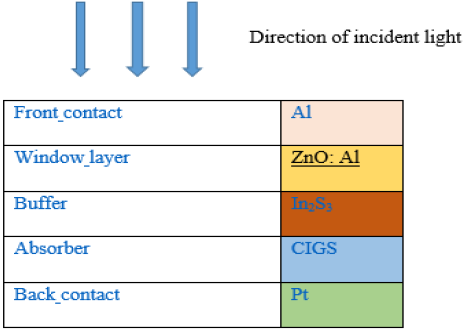Numerical Simulation of Copper Indium Gallium Diselenide Solar Cells Using One Dimensional SCAPS Software
Keywords:
SCAPs,, CIGS,, Multivalent defect,, buffer layer,, absorber,Abstract
The effect of multivalent defect density, thickness of absorber and buffer layer thickness on the performance of CIGS solar cells were investigated systematically. The study was carried out using Solar Cells Capacitance Simulator (SCAPS) code, which is capable of solving the basic semiconductor equations. Employing numerical modelling, a solar cell with the structure Al|ZnO : Al|In2S3|CIGS|Pt was simulated and in it, a double acceptor defect (-2/-1/0) with a density of 1014 cm-3 was set in the absorber in the first instance. This initial device gave a power conversion efficiency (PCE) of 25.85 %, short circuit current density (Jsc) of 37.9576 mAcm-2, Photovoltage (Voc) of 0.7992 V and fill factor (FF) of 85.22 %. When the density of multivalent defect (-2/-1/0) was varied between 1010 cm-3 and 1017 cm-3 the solar cells performance dropped from 26.81 % to 16.87 %. The champion device was with multivalent defect of 1010 cm-3 which shows an enhancement of 3.71 % from the pristine device. On varying the CIGS layer thickness from 0.4 um to 3.6 um, an increase in PCE was observed from 0.4 um to 1.2 um then the PCE began to decrease beyond a thickness of 1.2 um. The best PCE was recorded with thickness of 1.2 um which gave Jsc of 37.7506 mAcm-2, Voc of 0.8059 V, FF of 85.2655 %. On varying the In2S3 (buffer) layer thickness from 0.01 um to 0.08 um, we observed that there was no significant change in photovoltaic parameters of the solar cells as buffer layer thickness increased.

Published
How to Cite
Issue
Section
Copyright (c) 2021 Journal of the Nigerian Society of Physical Sciences

This work is licensed under a Creative Commons Attribution 4.0 International License.
How to Cite
Most read articles by the same author(s)
- Sherifdeen O. Bolarinwa, Eli Danladi, Andrew Ichoja, Muhammad Y. Onimisia, Christopher U. Achem, Synergistic Study of Reduced Graphene Oxide as Interfacial Buffer Layer in HTL-free Perovskite Solar Cells with Carbon Electrode , Journal of the Nigerian Society of Physical Sciences: Volume 4, Issue 3, August 2022
- Imosobomeh L. Ikhioya, Eli Danladi, Okoli D. Nnanyere, Abdulazeez O. Salawu, Influence of Precursor Temperature on Bi Doped ZnSe Material via Electrochemical Deposition Technique for Photovoltaic Application , Journal of the Nigerian Society of Physical Sciences: Volume 4, Issue 1, February 2022
- Eli Danladi, Jamila Tasiu, Lucky Endas, Preparation and Characterization of High Performance Dye Sensitized Solar Cells with Silver Nanoparticles in nanocomposite Photoanode , Journal of the Nigerian Society of Physical Sciences: Volume 2, Issue 1, February 2020
- Eli Danladi, M. Y. Onimisi, S. Garba, R. U. Ugbe, J. A. Owolabi, O. O. Ige, G. J. Ibeh, A. O. Muhammed, Corrigendum to "Simulation and Optimization of Lead-Based Perovskite Solar Cells with Cuprous Oxide as a P-type Inorganic Layer [J. Nig. Soc. Phys. Sci. 1 (2019) 72–81, https://doi.org/10.46481/jnsps.2019.13]" , Journal of the Nigerian Society of Physical Sciences: Volume 3, Issue 3, August 2021
- C. O. Lawani, G. J. Ibeh, O. O. Ige, Eli Danladi, J. O. Emmanuel, A. J. Ukwenya, P. O. Oyedare, Corrigendum to "Numerical Simulation of Copper Indium Gallium Diselenide Solar Cells Using One Dimensional SCAPS Software [J. Nig. Soc. Phys. Sci. 3 (2021) 48–58, https://doi.org/10.46481/jnsps.2021.133]" , Journal of the Nigerian Society of Physical Sciences: Volume 3, Issue 3, August 2021







